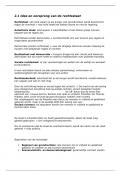Samenvatting
Summary Tutorial 1 Anxiety Disorders – Specific Phobias
- Instelling
- Maastricht University (UM)
Relevante literatuur verwerkt over specifieke fobie. Onderwerpen die aan bod komen zijn de DSM criteria, fysiologische reacties, conditioneren, Clark & Beck, Davey en behandeling (exposeer, response preventief).
[Meer zien]













